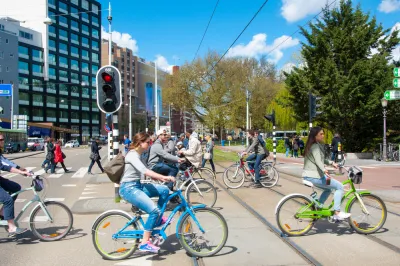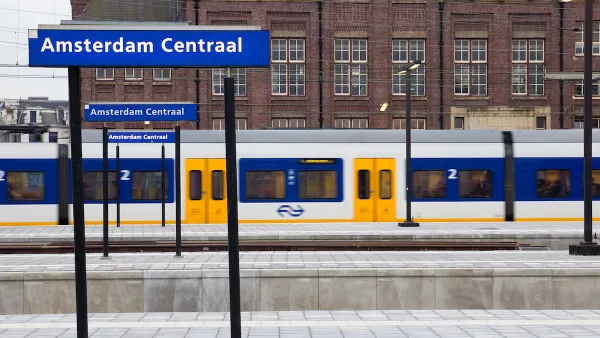European cities tend to be more walkable and transit-accessible—perhaps because they get the three Ds right (density, diversity, and design).

Last week, I went to Europe for the first time in over 20 years, and for the first time ever alone (as opposed to traveling with family or with a guided tour). Rather than going to the usual museums and tourist attractions, I explored Paris and Amsterdam the same way I would explore Detroit or Phoenix: as an urbanist, visiting as many neighborhoods as possible and comparing them to American cities.
Of course, both cities are far more walkable and transit-oriented than most American cities. In both, only about 30 percent of commuters use a car. Why?
Robert Cervero has written that three major elements affect travel patterns: density, diversity and design. Paris and Amsterdam are only moderately different from most American cities in the first two respects, but quite different in the last.
Compact cities tend to be more walkable and transit-friendly, because in a dense, compact city, more people can live within walking distance of shops and transit stops. Paris and Amsterdam are more dense than most of the United States—but not outstandingly so from my New York City perspective. Paris has about 55,000 people per square mile—more than New York City as a whole but less than Manhattan. Amsterdam is much less dense, with a little over 12,000 people per square mile- not many by New York standards, but still comparable to transit-friendly cities like Chicago and San Francisco. Even in Centrum (the most dense of Amsterdam's boroughs) there were only 28,000 people per square mile, only slightly more than the citywide average in New York.
In both cities, I stayed in transit-accessible suburbs rather than in the touristy, expensive core. But even in its suburbs, Paris seemed to have a high diversity of uses; it was very common to see shops on the ground floor of residential blocks, even in suburban Levallois where I stayed. This diversity makes it easier for people to walk to shops. Similarly, Centrum is mostly mixed-use. The post-World War II, suburb-y parts of Amsterdam, by contrast, do have areas dominated by residences. But in these neighborhoods, as in 1920s American streetcar suburbs, a commercial street was usually just a few blocks away.
The biggest difference between these cities and American cities, however, relates to design. Even in my Manhattan neighborhood, most street space is reserved for moving automobiles. By contrast, in Paris and Amsterdam there are fewer automobile lanes and more space for pedestrians (and, in Amsterdam, bicycles). In Levallois, I stayed on a two-lane street with one lane for parked cars and only one more lane for moving cars. Amsterdam had far more bike lanes, but also seemed to have a lot of one and two-lane streets. Narrow streets have obvious benefits for pedestrians and bicyclists: traffic is slower, and when you cross the streets you have fewer lanes to cross.
(Note: If you want to see photos of the neighborhoods I visited, the photos on my Facebook page are set as open to the public).

Analysis: Cybertruck Fatality Rate Far Exceeds That of Ford Pinto
The Tesla Cybertruck was recalled seven times last year.

National Parks Layoffs Will Cause Communities to Lose Billions
Thousands of essential park workers were laid off this week, just before the busy spring break season.

Retro-silient?: America’s First “Eco-burb,” The Woodlands Turns 50
A master-planned community north of Houston offers lessons on green infrastructure and resilient design, but falls short of its founder’s lofty affordability and walkability goals.

Test News Post 1
This is a summary

Analysis: Cybertruck Fatality Rate Far Exceeds That of Ford Pinto
The Tesla Cybertruck was recalled seven times last year.

Test News Headline 46
Test for the image on the front page.
Urban Design for Planners 1: Software Tools
This six-course series explores essential urban design concepts using open source software and equips planners with the tools they need to participate fully in the urban design process.
Planning for Universal Design
Learn the tools for implementing Universal Design in planning regulations.
EMC Planning Group, Inc.
Planetizen
Planetizen
Mpact (formerly Rail~Volution)
Great Falls Development Authority, Inc.
HUDs Office of Policy Development and Research
NYU Wagner Graduate School of Public Service





























